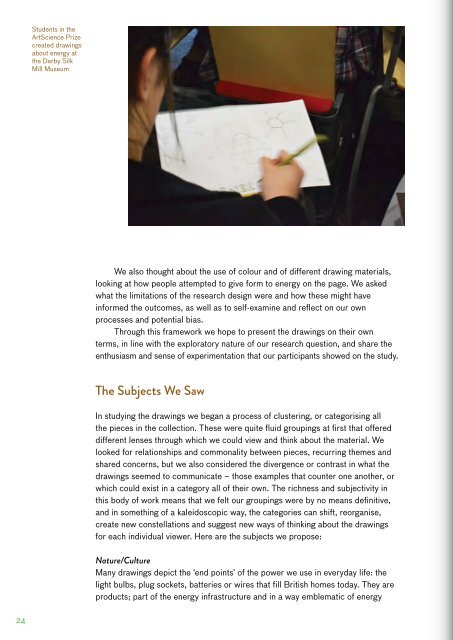Drawing Energy
Drawing-Energy-low-res
Drawing-Energy-low-res
You also want an ePaper? Increase the reach of your titles
YUMPU automatically turns print PDFs into web optimized ePapers that Google loves.
Students in the<br />
ArtScience Prize<br />
created drawings<br />
about energy at<br />
the Derby Silk<br />
Mill Museum<br />
We also thought about the use of colour and of different drawing materials,<br />
looking at how people attempted to give form to energy on the page. We asked<br />
what the limitations of the research design were and how these might have<br />
informed the outcomes, as well as to self-examine and reflect on our own<br />
processes and potential bias.<br />
Through this framework we hope to present the drawings on their own<br />
terms, in line with the exploratory nature of our research question, and share the<br />
enthusiasm and sense of experimentation that our participants showed on the study.<br />
The Subjects We Saw<br />
in contemporary culture. These images speak of end use, of daily interaction,<br />
immediate access and an at-our-fingertips kind of power. Time, convenience,<br />
connectivity and the domestic are important considerations in these images as<br />
they seem to reference the instantaneous, on-demand moment of connection<br />
we have with physical power on a daily basis. Importantly, they also speak of<br />
the human scale that the energy system ultimately translates into. Rather than<br />
consider the National Grid, or power stations, for example, they present the visible<br />
points of contact that people have with the energy system and show how the people<br />
behind these drawings experience energy in their immediate environment. A few<br />
children’s drawings also show images of food, two in fact show hamburgers, one<br />
labelled with the word ‘food’. While this is certainly distinct from the other products<br />
discussed above, it similarly relates to the ways in which people gain, come into<br />
contact with and benefit from energy sources.<br />
Of all the domestic products, we see light bulbs, most often (15 times)<br />
throughout the collection. Studies on energy conservation (see Attari et al., 2010<br />
and Kempton et al., 1985) have identified that people suggest actions such as<br />
turning lights out when leaving the room as an effective way to save energy, when<br />
it actually saves relatively little compared with heating and air conditioner use.<br />
This may be because lighting is often the most visible use of energy at home.<br />
We do not see the power running our computers or heating systems in the same<br />
way as turning on a light instantly and visibly changes the whole room. Therefore<br />
drawings of light bulbs could be representations of the most visible form of energy,<br />
and perhaps this recurring presence suggests that people are more aware of the<br />
visible ways they use energy than they are the invisible ones.<br />
In the collection, there is a drawing of a Wi-Fi symbol. It is a small pencil<br />
drawing, only a few centimetres across, leaving a lot of white space on the page.<br />
It was created by a teenage student in the ArtScience Prize study, and it is<br />
interesting that it equates a symbol typically associated with the Internet, with<br />
energy. No other drawing does this. One shows a computer and mobile phone<br />
(this was created by a child), but overall, the Internet and digital technologies<br />
rarely appear across the sample. In this second picture we also see a battery,<br />
In studying the drawings we began a process of clustering, or categorising all<br />
the pieces in the collection. These were quite fluid groupings at first that offered<br />
different lenses through which we could view and think about the material. We<br />
looked for relationships and commonality between pieces, recurring themes and<br />
shared concerns, but we also considered the divergence or contrast in what the<br />
drawings seemed to communicate – those examples that counter one another, or<br />
which could exist in a category all of their own. The richness and subjectivity in<br />
this body of work means that we felt our groupings were by no means definitive,<br />
and in something of a kaleidoscopic way, the categories can shift, reorganise,<br />
create new constellations and suggest new ways of thinking about the drawings<br />
for each individual viewer. Here are the subjects we propose:<br />
The ArtScience<br />
Prize students<br />
displayed their<br />
drawings on<br />
the wall<br />
Nature/Culture<br />
Many drawings depict the ‘end points’ of the power we use in everyday life: the<br />
light bulbs, plug sockets, batteries or wires that fill British homes today. They are<br />
products; part of the energy infrastructure and in a way emblematic of energy<br />
24 25


